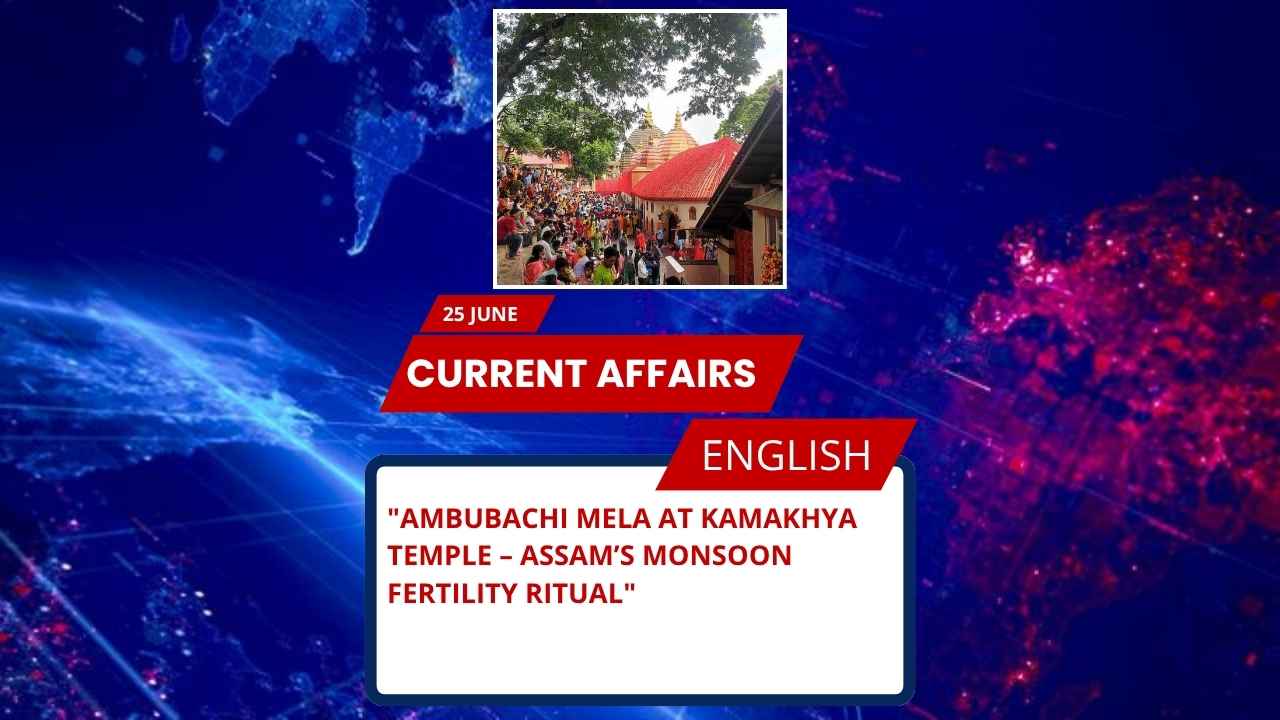
Key Points for SSC/UPSC and Other Govt Exams
- Ambubachi Mela is held annually at Kamakhya Temple, Guwahati (Assam).
- Celebrated during the Assamese month of Ahaar (June), coinciding with the monsoon.
- It marks the annual menstruation of Goddess Kamakhya, a symbol of fertility and creation.
- The temple remains closed for three days, and on the fourth day, reopens for darshan.
- Devotees receive Angodak (sacred spring water) and Angabastra (red cloth) as holy prasad.
- Assam government allocated ₹4.55 crore for arrangements in 2025.
- The festival promotes awareness about feminine energy and natural cycles.
- Over 7–8 lakh devotees attend the festival every year.
About Assam (For Exam Context)
- Capital: Dispur
- Chief Minister: Himanta Biswa Sarma (2025)
- Major Rivers: Brahmaputra, Barak
- Major National Parks: Kaziranga, Manas, Orang, Nameri
- Famous Temple: Kamakhya Temple, Guwahati
Complete Overview of Ambubachi Mela
What is Ambubachi Mela?
Ambubachi Mela is one of India’s most unique spiritual festivals, celebrated at Kamakhya Temple, a revered Shakti Peeth located on Nilachal Hill in Guwahati, Assam. The word “Ambubachi” means “water flowing”, signifying both monsoon rains and the goddess’s menstrual cycle. The festival is based on the belief that Mother Earth menstruates, and this phenomenon is represented through the goddess Kamakhya.
Religious and Cultural Significance
Unlike traditional idol worship, Kamakhya is worshipped as a yoni-shaped stone fed by an underground spring, symbolizing feminine creative power. During Ambubachi:
- The temple is closed for three days as it is believed the goddess is menstruating.
- Agricultural activities such as ploughing and sowing are paused, respecting the Earth’s natural rest.
- On the fourth day, the temple is reopened in a grand purification ceremony.
- Devotees receive:
- Angodak – holy water representing the goddess’s creative power.
- Angabastra – red cloth used to cover the yoni, kept by devotees as a protective amulet.
This celebration breaks the taboo around menstruation and symbolizes fertility, nurturing power, and spiritual transformation.
Govt Arrangements and Pilgrim Footfall
In 2025, Assam government allotted ₹4.55 crore for managing the mela:
- Two large pilgrim camps established.
- Clean toilets, bathing areas, and drinking water ensured.
- Medical camps and traffic diversions planned for safety.
- Around 8 lakh devotees were expected this year.
- Efforts made to promote tourism and spiritual significance of Kamakhya.
Kamakhya Temple – Historical Importance
- Kamakhya is one of the 51 Shakti Peethas, believed to be where Goddess Sati’s womb fell.
- No idol is worshipped here; instead, a stone yoni with a natural spring is the object of devotion.
- The temple was rebuilt in 1565 AD by the Koch dynasty, combining Nagara and Islamic architectural styles.
- It is a key center of Tantric Shaktism, attracting sadhus, aghoris, and tantrics from all over the world.
SSC/UPSC-Oriented MCQs
Based on Festival & State
- Where is the Ambubachi Mela celebrated?
A) Kedarnath Temple
B) Meenakshi Temple
C) Kamakhya Temple
D) Jagannath Temple - What does Ambubachi Mela symbolise?
A) Harvest
B) Victory over evil
C) Menstruation of the goddess
D) Lord Shiva’s marriage - What is Angodak?
A) Sacred flame
B) Red-colored sindoor
C) Holy water from the spring
D) Oil used in lamps - Which hill is Kamakhya Temple located on?
A) Trikuta Hills
B) Nilachal Hills
C) Vindhya Hills
D) Aravalli Hills - Which of the following national parks is in Assam?
A) Ranthambore
B) Bandipur
C) Kaziranga
D) Gir
UPSC-style FAQs with Model Answers
Q1. Explain the cultural significance of the Ambubachi Mela.
Answer:
The Ambubachi Mela reflects a profound respect for nature’s fertility and feminine power. Held at the Kamakhya Temple, it marks the annual menstruation of Goddess Kamakhya. Unlike mainstream practices that stigmatize menstruation, Ambubachi celebrates it as divine and powerful. Rituals such as temple closure, cessation of agricultural activity, and the offering of sacred items like Angodak and Angabastra highlight a culture that reveres natural biological processes. The festival also fosters community unity and promotes spiritual tourism.
Q2. Assess the role of the government in managing the Ambubachi Mela.
Answer:
The Assam government plays a critical role in managing the mass turnout of pilgrims during the Ambubachi Mela. In 2025, ₹4.55 crore was allocated for sanitation, camps, medical care, and traffic control. Strategic crowd management, cleanliness, and safety measures showcase effective planning. Moreover, the initiative supports the state’s goal of developing Kamakhya as a major spiritual tourism hub. However, challenges like commercialization, over-crowding, and lack of digital services for traders still exist, requiring long-term infrastructural planning.
Q3. How does the Ambubachi Mela redefine menstrual narratives in Indian society?
Answer:
Ambubachi Mela stands out as a cultural practice that normalizes menstruation rather than shaming it. By worshipping the goddess during her menstrual phase, it challenges deeply rooted stigmas in Indian society. The belief that Mother Earth menstruates and needs rest is symbolically powerful. This unique approach elevates menstruation as divine, helping shift public perception and promoting gender-sensitive discourse—a key concern in UPSC GS Paper II (Social Issues).
Q4. Why is Kamakhya Temple considered significant in Tantric Shaktism?
Answer:
Kamakhya Temple is a core site for Tantric practices, as it is believed to house the yoni of Goddess Sati. It is one of the 51 Shakti Peethas and holds immense importance for practitioners of Tantric Shaktism, a sect that emphasizes female power and energy. The temple does not house an idol but a symbolic representation of the womb, making it unique. It draws sadhus, tantrics, and spiritual seekers from across the world, and serves as a centre for esoteric rituals and spiritual awakening.
Conclusion
Ambubachi Mela is more than a religious gathering—it is a spiritual, social, and cultural celebration of femininity, fertility, and divine nature. From its sacred rituals to socio-religious relevance, it stands as a model of how tradition can positively influence progressive ideas in modern society. For aspirants of competitive exams, it provides a rich example of how India’s festivals can be understood through the lenses of culture, governance, and social reform.







